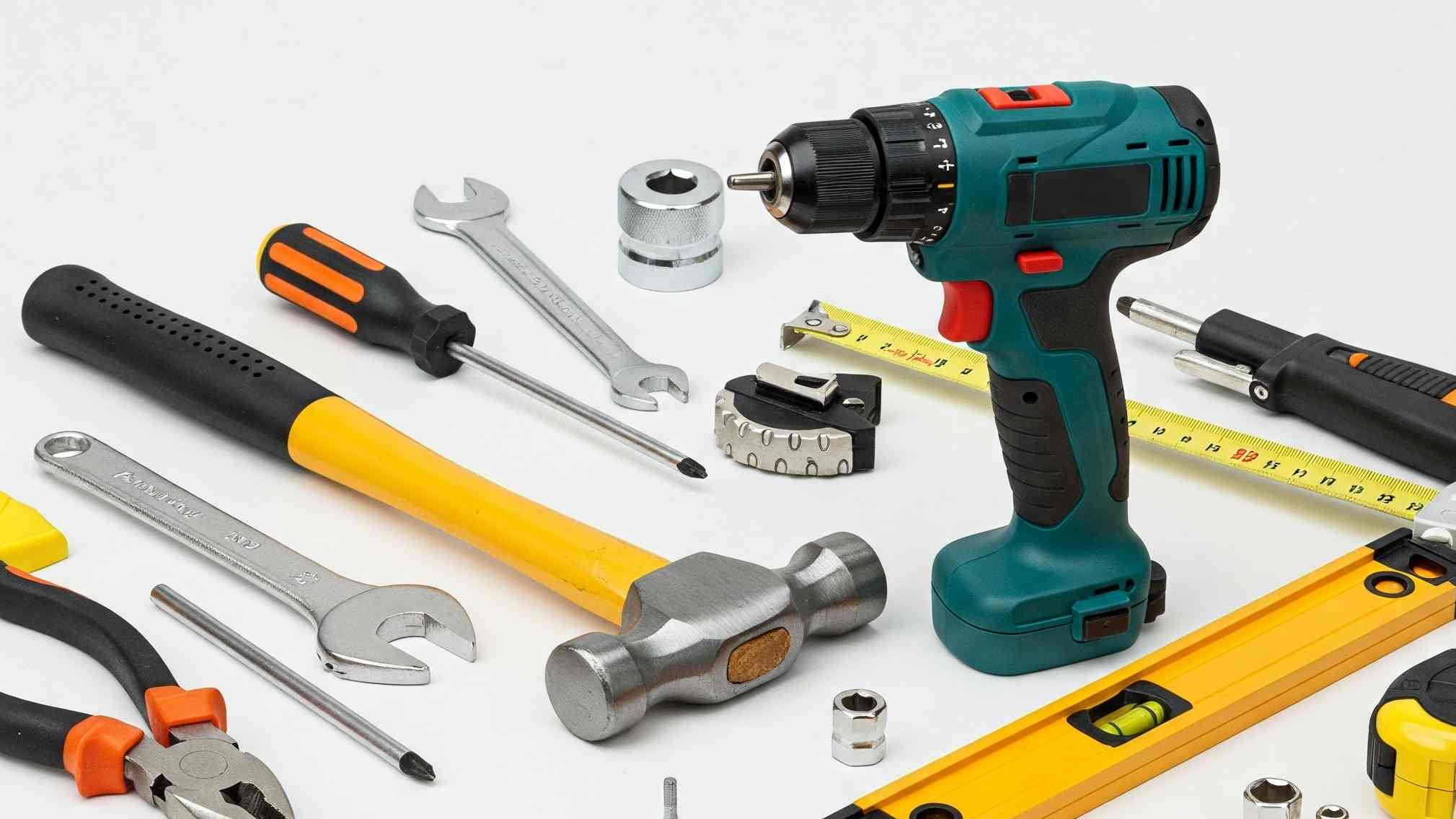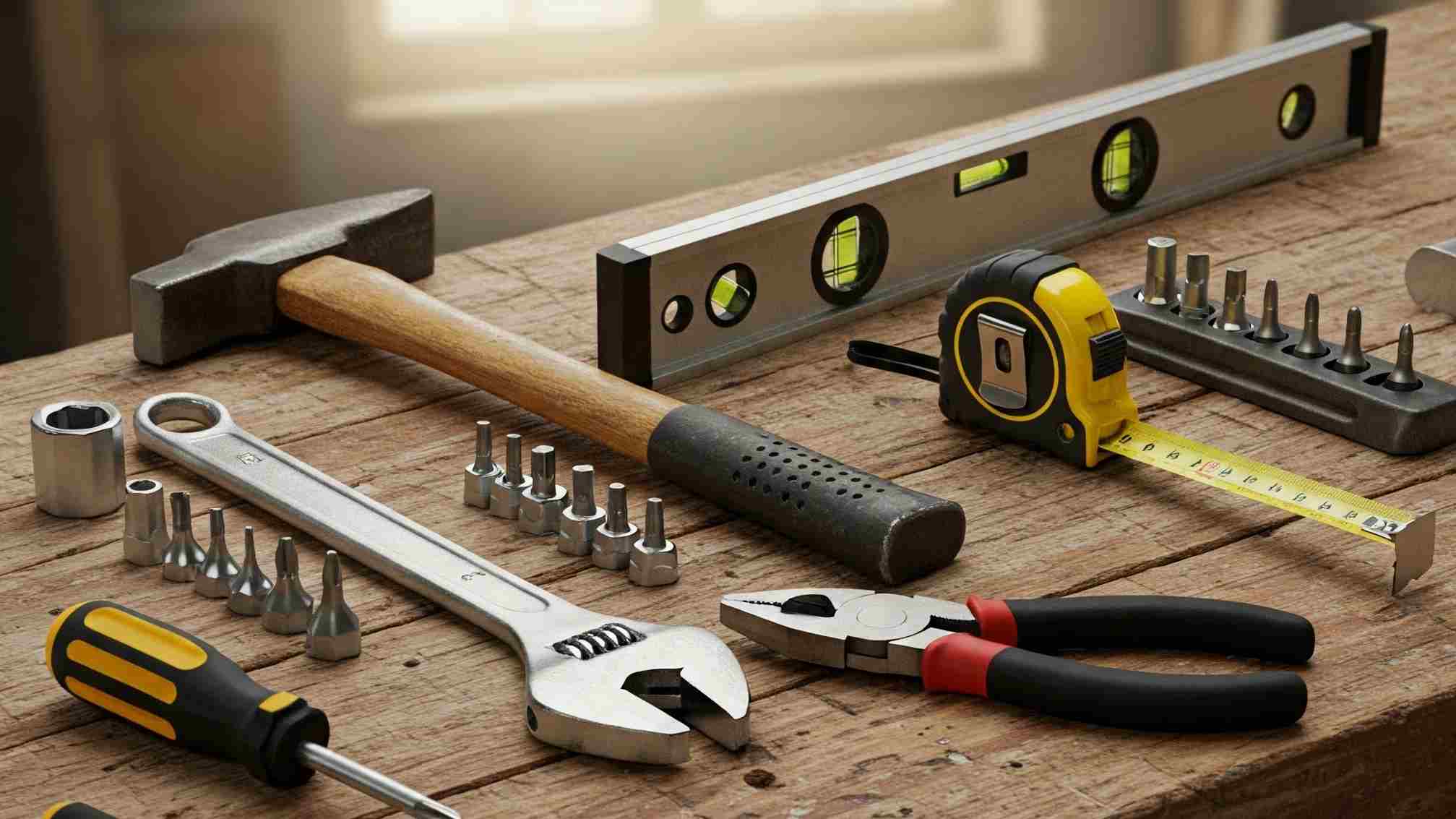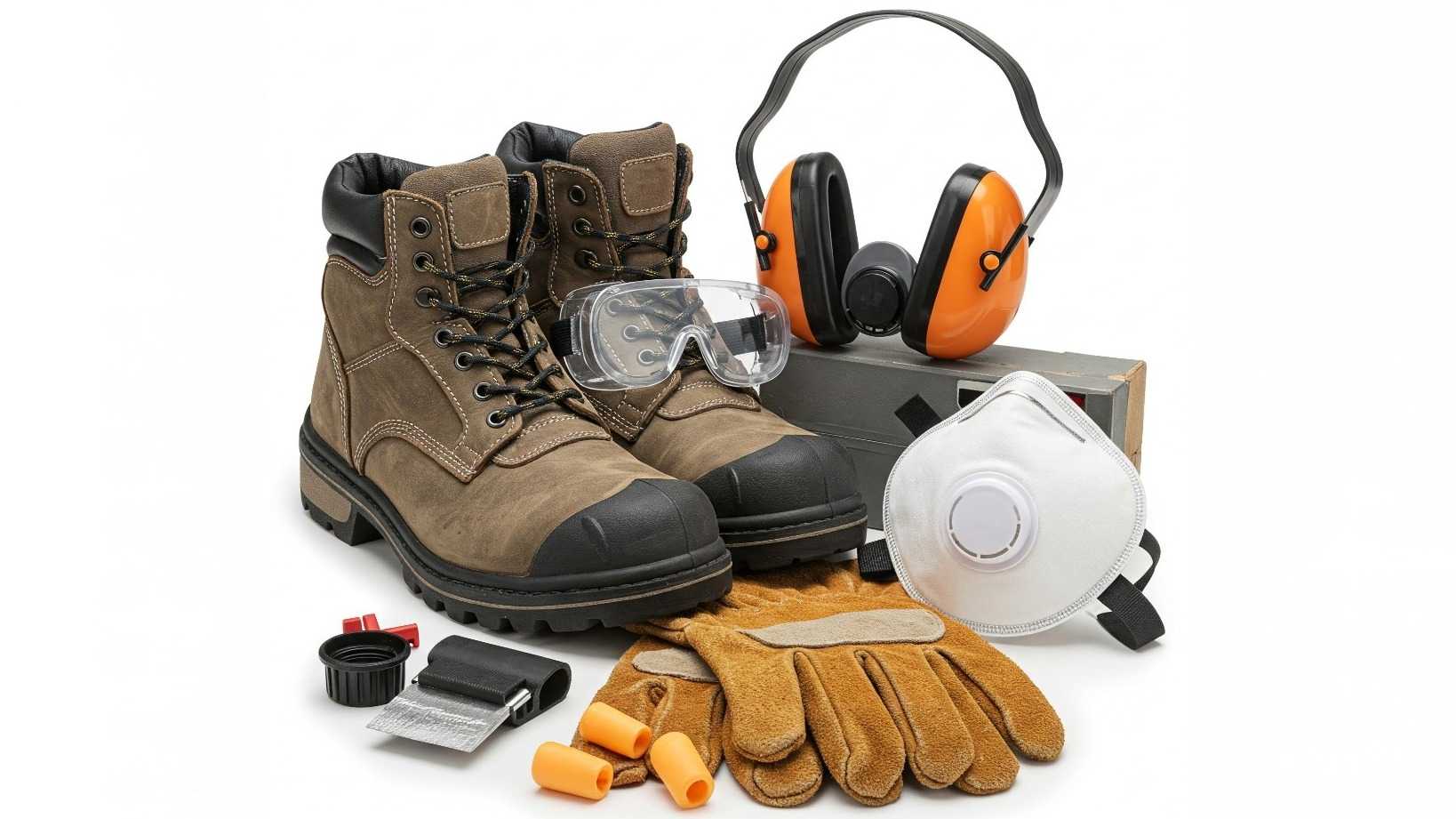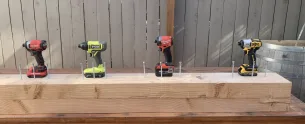Advertising Disclosure
Essential Tools Every Homeowner Needs: A Must-Have List
Owning a home comes with its share of responsibilities. They range from fixing a leaky faucet to hanging a picture frame or assembling furniture. However, having the right tools makes these tasks easier for every homeowner. It saves you time, money, and frustration. Whether you’re a new homeowner or looking to upgrade your toolkit, it doesn’t matter. A well-stocked set of essential tools is key to confidently handling:
- Repairs
- Maintenance
- DIY projects
With the right must-have tools, you can handle small fixes without calling a professional. This not only cuts costs but also gives you a sense of accomplishment. From essential hand tools like hammers and screwdrivers to power tools for bigger projects, we will guide you through the basic list every homeowner should have.
We’ll cover what you need for day-to-day tasks, advanced repairs, and even larger home improvement projects. We’ll also discuss safety gear and tool organization tips.
By the end, you’ll know the answer to the question “What tools do I need?” With them, you will keep your home in top shape and be ready for any project that comes your way.
The Basic Homeowner’s Tool Kit: Getting Started
Every homeowner needs a set of basic tools for home to handle everyday tasks like:
- Tightening a loose screw
- Assembling furniture
- Hanging curtains
These tools every homeowner should have form the foundation of a functional toolkit. They make small repairs and maintenance a breeze. A basic toolkit is cost-effective, easy to store, and ensures you’re ready for unexpected fixes.
Here’s a quick list of most useful tools to include in your starter kit:
- Hammer. This is useful for driving nails or light demolition.
- Screwdrivers. Consider both flathead and Phillips for various screws.
- Tape measure. It will be handy for accurate measurements.
- Pliers. Use it for gripping and twisting.
- Utility knife. Consider it for cutting materials like drywall or packaging.
Having these good tools to have at home means you won’t need to borrow from a neighbor or hire a handyman for minor tasks. They’re versatile, beginner-friendly, and perfect for:
- Assembling furniture
- Fixing cabinet doors
- Securing loose fixtures
Additionally, investing in quality tools ensures they’ll last for years. It will save you from frequent replacements. Start with these essentials. And you’ll be ready to make most small projects around the house with ease.
Hammer: The Most Versatile Tool in Your Home
A hammer is one of the best tools to have at home due to its incredible versatility. It makes it a cornerstone of any homeowner’s toolkit. Whether you’re hanging a picture frame, driving nails into wood for a DIY shelf, or performing light demolition like removing old tiles or breaking apart drywall, a hammer is an absolutely necessary tool. Its simplicity and effectiveness make it vital for:
- Routine maintenance
- Creative projects around the house
The claw hammer is the most common tool that every homeowner should have. It features a flat striking surface for pounding nails. And it has a curved, claw-like end for pulling them out with ease. Claw hammers are lightweight, typically weighing around 16 ounces, making them ideal for general tasks without causing fatigue. For most home projects, this type offers the perfect balance of power and control.
However, other hammer types may be useful for specialized tasks. For example, sledgehammers for heavy demolition or ball-peen hammers for metalwork. But they’re less common in a standard home toolkit.
When choosing a hammer, focus on quality and comfort. A 16-ounce claw hammer with a non-slip, ergonomic grip ensures ease of use. It’s especially helpful during extended projects. The handle material is also key. Fiberglass or steel handles are far more durable than usual wooden ones. They resist cracks and wear over time. A well-made hammer fits comfortably in your hand for tasks like:
- Assembling furniture
- Securing fence posts
- Prying apart stuck objects
With this important tool, you’ll be ready to tackle a wide range of home repairs and DIY endeavors with confidence and precision, whether it’s minor fixes or ambitious builds.
Screwdrivers and Drill: Essential for Assembly and Repairs
No toolkit is complete without a quality set of screwdrivers and a drill. These versatile tools are essential for homeowners, being indispensable for a wide range of tasks. These tasks range from assembling furniture to performing minor repairs. This makes them good tools to have in any home. Whether you’re a seasoned DIYer or a new homeowner, having them on hand ensures you can tackle everyday projects with ease and precision.
Screwdrivers come in two most useful tool types:
A comprehensive set includes multiple sizes – small, medium, and large, ensuring you’re ready for any screw you encounter. These tools are critical for tasks like:
- Tightening cabinet handles
- Assembling a bed frame
- Fixing a loose hinge
- Securing electrical outlet covers
For more convenience, consider a ratcheting screwdriver with interchangeable bits. It reduces the need for multiple tools and saves space in your toolbox.
A power drill elevates your capabilities, making it faster and less labor-intensive to drive screws or drill holes for:
- Wall anchors
- Shelves
- Fixtures
Cordless drills are the go-to choice for home use. They offer portability and sufficient power for drilling into materials like:
- Wood
- Drywall
- Light masonry with the right bits
Look for a drill with adjustable speed settings and a variety of interchangeable bits for both drilling and screwdriving tasks. This versatility makes this essential tool ideal for repetitive tasks, such as:
- Installing curtain rods
- Mounting a TV
- Securing furniture to walls for safety
Investing in quality screwdrivers and a reliable cordless drill saves time. Additionally, it reduces physical strain and ensures professional results. These must-have devices empower you to tackle everything from simple fixes to more complex projects. This level of confidence and efficiency will make these tools a cornerstone of any homeowner’s toolkit.
Advanced Tools for Home Repairs and Maintenance
Once you’ve got the basics covered, it’s time to consider important tools for more advanced repairs like:
- Plumbing fixes
- Electrical work
- Home improvement projects
These must-have tools for home allow you to tackle complex tasks without relying on professionals. With them, you can ensure you use them safely and know your limits.
The important tools are pliers, wrenches, and a sturdy tape measure. They are invaluable for precise and technical work. For example, fixing a leaky pipe or tightening a bolt requires specialized tools that go beyond a hammer or screwdriver. Investing in these essential tools ensures you’re ready for unexpected issues, like a clogged drain or a loose electrical fixture.
But remember, always focus on safety by:
- Reading manuals
- Watching tutorials
- Using protective gear when handling advanced tools
With the right equipment, you can confidently maintain your home and save on costly repairs.
Tape Measure: For Precision and Accuracy
A tape measure is one of the best tools to have at home. It serves as a cornerstone for ensuring precision and accuracy in many home projects. With it, you can measure a room for new furniture, hang artwork at the perfect height, and cut materials for DIY projects.
A reliable tape measure is a necessary tool that guarantees your measurements are spot-on. Without it, you risk costly and frustrating mistakes. For example, buying a rug that’s too large, drilling holes in the wrong spot, or misaligning shelves. Those mistakes can fail even the simplest tasks.
Choosing the right tape measure is critical. Opt for one that’s at least 25 feet long to accommodate larger spaces. Consider one with a sturdy, retractable blade that withstands frequent use. Key features to look for include:
- A locking mechanism to hold measurements in place
- A belt clip for easy portability
- A wide blade that stays rigid when extended
Some advanced models offer magnetic tips. They are handy for solo measuring on metal surfaces.Or some offer even laser measuring capabilities for pinpoint accuracy over long distances. These features make it versatile for both indoor and outdoor tasks.
This must-have tool is simple yet indispensable for a wide range of projects. Use it to:
- Measure window frames for custom blinds
- Space shelves evenly
- Plan a garden layout
- Ensure furniture fits through doorways
Its compact design makes it easy to store in any toolbox. Its durability ensures it will last for years. Keep a tape measure handy. And you’ll find yourself reaching for it more often than expected, whether you’re tackling decor projects or large renovations. With a tape measure in your toolkit, you’ll approach every project with confidence, taking precise measurements that save time and avoid costly errors.
Pliers and Wrenches: Must-Have for Plumbing and Repairs
Pliers and wrenches are must-have tools for home. They are essential for tackling a variety of plumbing issues and general repairs. Every homeowner inevitably faces these issues from time to time. These tools for homeowners are indispensable for tasks requiring:
- A strong grip
- Precise twisting
- Secure fastening
This versatility makes them critical additions to any toolkit. From fixing a leaky faucet to assembling furniture, pliers and wrenches provide the strength and versatility needed to handle maintenance challenges with confidence.
Pliers come in several types. And each is suited for specific tasks:
- Needle-nose pliers are those with their thin, elongated jaws. They’re perfect for gripping small objects, bending wires, and working in tight spaces. This is especially useful when repairing electronics or jewelry.
- Locking pliers, often called vise-grips, can clamp materials together. They act as an extra set of hands when gluing or securing parts. This makes them ideal for holding pieces in place during complex repairs.
For homeowners, a combination of these pliers ensures you’re ready for diverse tasks. Those can range from twisting wires to extracting stubborn nails.
As for wrenches, they are equally vital. It’s particularly for plumbing and mechanical repairs. An adjustable wrench is a versatile choice. Its adjustable jaw fits various sizes of nuts and bolts. It makes it perfect for tasks like assembling gym equipment or tightening appliance fittings. A pipe wrench is for gripping round objects like pipes. Pipe wrenches are essential for plumbing tasks such as fixing leaks or installing faucets. These good tools to have at home are built to provide the torque needed to loosen or tighten fittings securely.
With pliers and wrenches in your toolkit, you’ll address a wide range of challenges. These range from repairing dripping faucets to securing outdoor furniture or assembling heavy machinery. These important tools empower homeowners to handle repairs efficiently. They save time and money while ensuring a job well done. Keep them accessible, and you’ll find them indispensable for maintaining your home.
Power Tools for Bigger Home Improvement Projects
For homeowners tackling larger projects like remodeling a room, building furniture, or installing tiles, essential tools for homeowners include power tools. These tools:
- Save time
- Increase efficiency
- Make it possible to work with tougher materials like hardwood or metal
These tools require a bigger investment. However, their versatility makes them worth it for frequent DIYers.
Common power tools include:
- Power drill. It’s needed for drilling holes and driving screws.
- Circular saw. This one is for cutting wood or metal.
- Jigsaw. This is for curved or intricate cuts.
- Sander. It is for smoothing surfaces before painting or staining.
Power tools can be intimidating. However, with proper training and safety precautions, they’re game-changers for home improvement, whether you’re building a deck or renovating a bathroom. These best tools to buy will help you achieve pro results without hiring a contractor.
Power Drill: A Step Up from Handheld Tools
A power drill is one of the most useful tools for homeowners taking on bigger projects. Unlike manual drills, a power drill can easily bore through tough materials like:
- Concrete
- Metal
- Hardwood
It’s also a time-saver for driving screws into dense surfaces or assembling large furniture pieces.
Cordless power drills are the most practical for home use. They offer mobility and sufficient power for tasks like:
- Installing shelves
- Drilling holes for pipes
- Mounting a TV
Look for a model with adjustable speed settings and a variety of bits for drilling and screwdriving. Some drills even come with attachments for sanding or grinding. A power drill is a significant upgrade from handheld tools. It gives you the power and precision needed for ambitious DIY projects.
Saw: Cutting Wood, Pipes, and More
A saw is a necessary tool for any homeowner tackling projects. These projects involve cutting through materials like wood, metal, or plastic. This makes it a cornerstone of a well-equipped toolkit. Whether you’re building custom furniture, renovating a room, or performing routine repairs, it doesn’t matter. The right saw ensures precise and efficient cuts. With various types available, each designed for specific tasks, selecting the right saw can make all the difference in achieving pro-quality results for your DIY endeavors.
A circular saw as a tool for homeowners is a top choice for making straight, clean cuts in lumber or plywood. Its powerful blade is ideal for projects like:
- Framing walls
- Constructing a deck
- Building bookshelves
A jigsaw, on the other hand, excels at curved or intricate cuts. This makes it perfect for shaping decorative pieces, cutting out sink holes in countertops, or crafting custom designs. For smaller, more precise tasks, a hacksaw is excellent for cutting through:
- Metal rods
- Pipes
- Even plastic (installing plumbing or trimming hardware)
Each saw type has unique strengths. So choosing the right one depends on your project’s requirements. For instance, a hand saw is great for trimming tree branches or cutting small pieces of wood, while a wet saw is essential for slicing through ceramic or stone tiles during bathroom or kitchen renovations. Versatility is key. And owning a couple of saw types can prepare you for a wide range of tasks.
Safety is critical when using saws, as their sharp blades and power can pose risks. Along with the right tools for every homeowner’s needs, always wear protective gear. It usually includes:
- Gloves to prevent cuts
- Safety goggles to shield your eyes from debris
- Ear protection for noisy power saws
With the right saw in your toolkit, you’ll be well-equipped to handle cutting tasks for renovations, repairs, or custom builds, ensuring accuracy and efficiency in every project from simple fixes to big home improvements.
Essential Safety Gear for Homeowners
Safety is a top priority when using essential hand tools for home repairs or DIY projects. Without proper protection, even simple tasks can lead to injuries. Investing in safety gear is just as crucial as buying the best tools to have at home.
Here’s a basic list of essential safety gear for tools:
- Safety goggles. These tools protect your eyes from dust, debris, or flying particles.
- Work gloves. They prevent cuts, blisters, or burns when handling tools or materials.
- Ear protection. It helps reduce noise exposure when using loud power tools like saws or drills.
- Dust mask or respirator. They keep your lungs safe from sawdust or chemical fumes.
- Steel-toed boots. They protect your feet from heavy falling objects.
Always inspect tools before use to ensure they’re in good condition. And remember to follow manufacturer instructions. For power tools, unplug or remove batteries when not in use to prevent accidents. Always prioritize safety. Then, you can enjoy DIY projects with peace of mind. This way, you will know you’re safe from potential hazards.
Maintenance and Storage Tools: Organizing Your Toolbox
Keeping your basic tools for home in excellent condition and well-organized is crucial. This ensures they remain efficient, reliable, and long-lasting. A cluttered toolbox can slow down your projects. It can make it difficult to find the right tool and even lead to damage over time. By investing in proper maintenance and storage solutions, you can protect your essential hand tools, keeping them in top shape and ensuring they’re always ready when needed. An organized and well-maintained toolkit not only saves time. It also enhances the overall enjoyment of your DIY and repair projects.
Consider this basic list of storage and maintenance tools into your setup:
- Toolbox or tool bag. Provides a secure, portable solution for storing tools, protecting them from dust, moisture, and damage.
- Tool rack or pegboard. Mounts on a wall to organize tools for quick, easy access. It keeps your workspace tidy and efficient.
- Cleaning supplies. Includes brushes, rags, and rust-preventive sprays. They are to remove dirt, grease, or corrosion from tools after use.
- Sharpening stone. Maintains the sharpness of blades, such as utility knives, chisels, or garden shears, for precise and safe cutting.
- Silica gel packets. Absorbs moisture in tool boxes or storage areas. It prevents rust on metal tools.
Regular maintenance is key to extending the life of your must-have tools. After each use, clean tools thoroughly. Remove debris, sawdust, or grease. It’s especially true for metal tools like wrenches, pliers, or saws. They are prone to rust. Apply a light coat of oil to metal surfaces to protect against corrosion. For power tools, inspect cords and batteries for wear. And keep them in protective cases. Always store your tools in a dry, cool environment to avoid moisture damage. It can degrade both metal and wooden components.
An organized toolbox streamlines your workflow. It can make projects smoother and more enjoyable. By dedicating time to proper tool care and storage, you’ll prevent unnecessary wear. This way, you reduce the need for replacements. And it ensures your toolkit remains a reliable asset for all your home maintenance and DIY endeavors.







